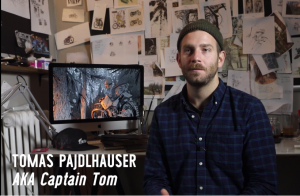The fight’s not over. Share your story. Send us your story, we’ll post it here. 
I’ve been working in the animation industry for over 15 years here in Nova Scotia. This is back when the television animation industry had just begun here in the province. I started out as a 2D digital animator, and later became a director and supervisor of over 400 episodes of broadcast television for many different series, with clients ranging from Warner Bros, Nickelodeon, YTV, Teletoon, and BBC.
Most people are unaware of how many hundreds of hours of animation content has been produced in Nova Scotia. Shows like Teen Titans GO!, Johnny Test, Roy, Tilly & Friends, Busytown Mysteries, Top Cat, Wild Grinders, George of the Jungle, Delilah & Julius, Bromwell High, Poko, Bruno & The Banana Bunch, Garth & Bev, Speed Racer, Bravoman, Star Girls, Miracle Koala, Olliver’s Adventures, just to name a few, plus countless music videos and commercials.
There are several animation and visual effects programs being offered in Nova Scotia that are made to train for these fields; filmmaking, digital animation, 3D animation/design, sound engineering, and many other technical and artistic categories that work in the film & television industry.
Without the subsidies and incentives derived from these tax credits, there will be no reason for these programs to exist, no reason for these students to take these courses, no reason for any work to be injected into this province. For animation alone, millions of dollars per year comes to Nova Scotia from the U.S. and Europe and other parts of Canada for productions to get made. It comes here because we are competitive with other provinces and other countries. What other industry in this province draws hundreds of artists to this province to make cartoons for other provinces and other countries at such high budgets?
The animation community 16 years ago had barely begun. In the early days, Salter Street Films, PixelMotion, CageDigital, Electropolis, Adner/Helix, Collideascope, and many others helped to build the foundation of the animation community that is the large, healthy and growing populace it is today.
I don’t want to leave this province. I’m from here. I live here. I work here.
Ron Doucet
#FacesOfFilmNS
#NSfilmjobs #NSFilmTaxCredit #NSFilmJobs #ScreenNovaScotia




Live by the tax credit. Die by the tax credit.
As a Canadian who was in Los Angeles for 15 years, I had no desire to leave California or home, but was forced to relocate to Vancouver because of the combined tax credit and the DAVE program which paid for 58% of the labor costs on any production. I had to move or lose my job.
Animation and visual effects is a zero profit industry. The margins are extremely low, 0-5% unless you control and own the IP you are working on. In most cases companies that profit are in the US, the television networks, production companies and toy companies that own the IP.
Taxpayer money should not be tossed into a pit, it’s the largest scam Hollywood baked up, let regional tax payers fight it out in free handouts. The money isn’t going to the local economies, it’s discounted off the cost of the production (as in you won’t get a show awarded unless you are in a subsidized location).
Sure you get local jobs, but you are losing the money on it. And the jobs are always temporary. It’s not sustainable because none of these productions can survive on their own without government money. We’re the ultimate welfare workers with 48-100% of our labor being covered by taxpayers with NO PROFIT participation for the government.
I had to leave Atlantic Canada 2 decades ago to work in the industry, back then it was Toronto or Los Angeles. That’s the reality before the government handouts begin.
And even then it wasn’t great, you only needed a small domestic team since most of the work was sent to Asia.
Hi polyphemus.
I have to agree with you on the idea that the entertainment industry relies very heavily of these labour tax credits and that is a problem. One that needs a solution that includes leaders in the industry discussing how to evolve this collectively with all levels of government.
The tragic Canadian way of doing things is for provinces to think of themselves as independent when it comes to economic reasoning.This is a problem when everyone is trying to compete for the same “sexy”(never felt that way to me) jobs in this old entertainment business.
So when one province decides to completely change the rules and no one else has, then there will be far reaching repercussions.
I don’t see any taxpayer money being tossed into a pit, as you say. I see a small yet flourishing industry that had around 25 million a year in rebates from the provincial government that enables some 150 productions to spend upwards of 150 million in the provence.
This would include everything from the hiring of the craft services company to buying gas at the local station.
Some 2000 people employed that are tax paying people, earning decent wages that are being spent of consumables and such in the provence.
This is a Cut Off My Nose Despite My Face kind of mentality.
It happened in NB
It happened Sask
Thriving hubs of industry they are not nor were, but had the starts of doing quite well and bringing in jobs other than bank tellers and call centre employees. Both of which by the way are getting FAR more provincial money than the film industry combined.
I don’t disagree that the system is flawed and that there are always going to be large companies that will find ways to take advantage of it. The old tax credit in Canada was way better but thanks to porn, was removed. Private investors used to be encouraged to invest in small features and their investment was a tax right off.
With the change to the NS system, they have given no lead time for studios to even try and adjust. Since the announcement there have been several productions that have already said they are pulling out. A loss of millions to the local economy. It isn’t just animation and VFX that are hurt. It’s the entire ecology from the local grocery store to the equipment rental companies.
Leave it to a Maritime government to find yet another way to keep the province in the barely post 1930’s depression era economy.